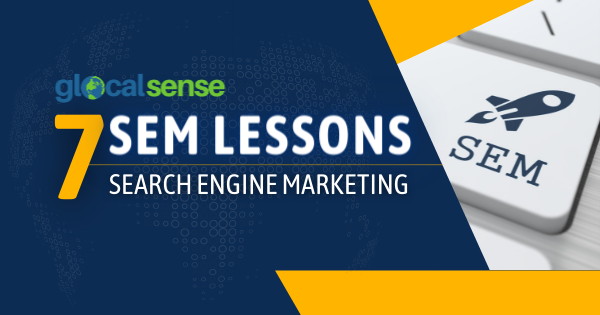Search engine marketing (SEM) is one of the most effective ways to generate free or low-cost traffic to your website, blog, or online business. Digital marketers must develop SEM techniques, such as paid search marketing and search engine optimization, to capture this traffic.
However, with much information available, it can be challenging for marketers to find out how to improve their skills and start seeing results as quickly as possible.
Search engine marketing (SEM) is a paid method of marketing that helps a company boost the visibility and traffic of a website in a targeted manner by marketing it on search engine pages. SEM can assist you in meeting your business objectives and exposing your company to a worldwide audience.
SEM primarily means marketing your brand on search engines like Google, Microsoft Bing, and their partner and network search engines.
SEM is often focused on pay-per-click advertising and paid search campaigns, although it can also involve SEO activities to capture organic search traffic.
SEM terminology
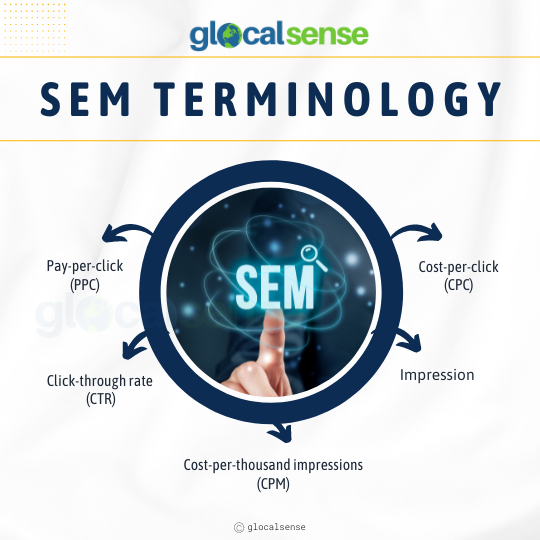
It is crucial to understand the relevant terminology. Before we get started, here’s a brief list of what you need to know:
1. Pay-per-click (PPC): Most search engine marketing services use this payment model, which requires you to pay a fixed fee for each click on your online advertisement.
2. Cost-per-click (CPC): The amount paid for a single click in PPC advertising is the cost-per-click (CPC).
3. Impression: A single impression is made when an advertisement is shown. An impression should not be confused with a point of view. Your ad may appear in the search results, but the user may not see it or intentionally ignore it.
4. Cost-per-thousand impressions (CPM): Another key payment model in SEM implies paying a fixed fee for every 1000 times the ad is shown to users.
5. Click-through rate (CTR): The ratio of users who clicked on your online ad (and landed on your website) to the overall number of people who saw it.
What Is the Importance of SEM?
Your company competes for the attention of potential customers in an exceedingly competitive virtual marketplace with millions of other enterprises. Before shopping online, consumers conduct research and use search engines like Google, Microsoft Bing, and Yahoo to conduct their searches. When consumers type in a search query, they usually want to learn more about a product or service, with some of them intending to buy it.
As a result, SEM is an important digital marketing approach for growing your brand’s reach and enhancing the ranking of your website. SEM will eventually result in more significant visitors to your website and conversions for your brand.
How does SEM work?
Paid search or pay-per-click (PPC) advertisements are commonly used in SEM. These pay-per-click advertisements display at the top of the Search Engine’s Results Pages (SERPs) or on the search engine’s marketing platform. Google AdWords, Microsoft Ads, and Yahoo Search Ads are a few of the most well-known marketing platforms. The tag “Ad” next to the links in PPC advertising makes them easy to recognize. They can also appear as display advertisements, social ads, remarketing ads, or instream ads.
Search engines use complex algorithms to return the most relevant results when users enter a search query. Bidding systems are used in search engine ad platforms. It would be best if you bid on keywords and target audiences.
If you are using paid SEM to promote your website, you will:
1. Select the keyword that you want to use for your PPC ad
2. Identify the location where you want your ad to be promoted
3. Optimize the content of the ad that will appear on the SERP
4. Make a bid on how much you are willing to pay for each click on your PPC ad
7 Best Benefits of Search Engine Marketing in 2022 and Beyond
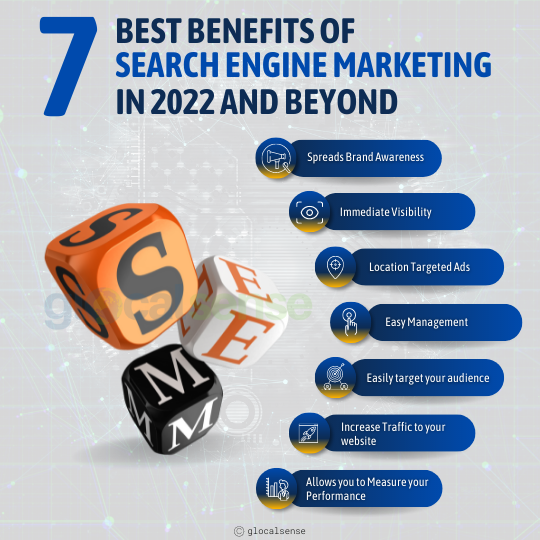
We can look at some of the benefits of SEM now that we’ve answered the question “What is SEM?” Remember, however, that many of these benefits are dependent on the proper implementation of SEM tools and techniques.
Here are the seven best benefits of Search Engine Marketing in 2022:
1. Spreads Brand Awareness
Paid advertising combined with SEO can help your product beat out the competition. In addition, these types of adverts can create a lasting impact on customers when it comes to product feedback, whether it’s a title or a URL link.
When combined with other types of product awareness, it can gradually or quickly distract you from your target audience.
2. Immediate Visibility
Using organic search engine optimization to gain visibility takes time and effort. Search engine marketing, on the other hand, provides practically immediate results. If customers are likely to be interested in you, your ad will appear in front of them. As a result, it’s an excellent short-term technique for gaining attention for your product, service, or organization.
3. Location Targeted Ads
Another great benefit of SEM is limiting your ads to people living near your organization. This option allows you to filter queries far away from your current location.
It also aids in introducing your brand to people in your locality. As a result, local audiences are ready to learn about local businesses. Perhaps this is why Google’s search results for “near” and “where to buy” have increased by 200 percent in the previous two years.
4. Easy Management
Another attractive aspect of search engine marketing is its ease of use. Platforms such as Google Ads make it simple to generate and manage any advertisements you use with the service.
For example, create multiple ad schedules that allow them to play or stand inside the time constraints of your budget. This editing method ensures that you complete the ad before ending it.
5. Easily target your audience
As already said, search engine marketing allows you to target customers in your company’s immediate vicinity. However, this isn’t the only way SEM can help you get it in front of the right audience. For example, different age groups, races, and social and economic groups use different keyword searches.
As a result, using keywords in your ads may help you connect with potential customers interested in your product.
6. Increase Traffic to your website
When content users search for your interests-related interests, ads on your website are frequently the first thing they see. This aspect is especially useful if you’re having problems getting organic visitors from SEO. Appropriately used, paid advertising will help increase traffic until you generate organic traffic yourself.
7. Allows you to Measure your Performance
In real life, evaluating the performance of advertising campaigns is often complex and expensive. They’ll need polls, focus groups, and other such resources. On the other hand, SEM platforms like Google Ads may provide you with instant access to the most effective keywords, impressions, and click-through rates. This benefit is one of the great differentiators of SEM over traditional advertising. You can use these techniques to determine how effective your advertisement is.
You can rapidly change your plan and run more successful search engine advertising if you discover that one ad performs better than the other.
A successful SEM campaign can provide lots of advantages to your brand. First, however, having a responsible person who knows what they’re doing is important.
8 Search Engine Marketing strategies and lessons that guarantee high brand visibility
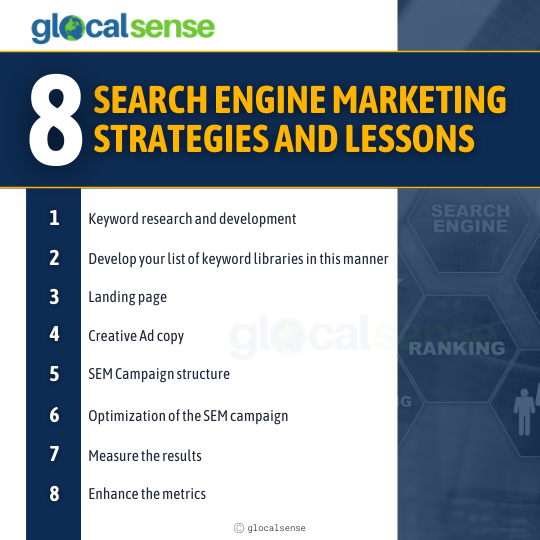
Although Search Engine Marketing is faster than SEO, it does not guarantee the same outcomes if the right tactics aren’t applied. Paid ads can be used for various purposes, including brand awareness and lead generation. Before starting any campaign, make sure you know what you want to achieve and how much you’re willing to pay to get to the top.
1. Keyword research and development
Keywords are the most important element for your audience to learn more about you and your brand’s services. Consider how your target audience searches for terms and what keywords they use to find a specific product.
• Conversion rates are high
• A higher click-through rate (CTR) can generate more traffic to the site
2. Develop your list of keyword libraries in this manner
Put yourself in your customer’s position and target the terms that will drive traffic to your website. It could include your company’s name, product, or value-added services they’re searching for.
• The terms users search for are included in the product or service keyword list.
• Affinity keywords are terms that create a free relationship with your business.
• Longer, more explicit terms, such as 3-5 word phrases, are included in the long-tail keywords list.
The list of negative keywords contains terms that you should avoid using. Because these terms attract unimportant traffic, it’s best to use them as channels instead of spending your ad resources on them. You may increase the nature of your traffic over time by improving your negative keyword list, resulting in more leads and customers.
3. Landing page
Here are a few tips to help you improve your landing pages:
• First, experiment to see if your pages need to be modified to be compatible with your SEM postings.
• Test all connections to ensure that each posting appears on the right page.
• Make sure the site provides the services you need so you can keep track of all customers.
• Make transformations simple with a few strong calls to action and an easy-to-use interface.
4. Creative Ad copy
Creating an ad copy does not appear to be a sales pitch. So first and foremost, brands should concentrate on the creative aspects of their campaigns and generate ad content that is not:
• Deception or misrepresentation
• Drawing unneeded and irrelevant traffic
• Containing any irrelevant terms.
Consider how to create a convincing advertisement that catches viewers’ attention and tempts them to learn more about the brand and its services.
5. SEM Campaign structure
• Create keyword classes based on the search engine you’ll use to run the campaign.
• To ensure that the URLs highlight the correct pages, test them for each keyword.
• Examine your ad copy to ensure it is error-free.
6. Optimization of the SEM campaign
The key aspect of optimizing the campaign is testing and monitoring. The more dynamic a keyword is, the more comprehensive your examination. You should always try something new, and you should always look for ways to improve your aim with minor changes that improve the performance of SEM techniques.
Over time, keep track of your changes to discover where you’re falling short. You can pinpoint the problem areas and work to resolve the issues and challenges as you go.
7. Measure the results
Take a close look at the results. You may calculate the ROI of each strategy and compare it to the average ROI of different campaigns.
8. Enhance the metrics
When you need to improve your goals, keep your objectives in mind. You can make changes to correct activities and bid your budgets effectively if you understand the connections between key audiences.
The 10 Best Search Engine Marketing (SEM) Tools for 2022
One thing remains constant in digital marketing: top-of-funnel clients begin their journey with search engines. Data from BrightEdge shows that 68% of all website traffic comes from an organic or paid search. SEM (search engine marketing) optimizes your position in search results by combining paid and organic strategies.
SEM success requires using the right keywords, a well-planned budget, and excellent ad design. These tools might help you generate new keyword ideas and improve your marketing strategy. Here find the paid and free tools list for your knowledge.
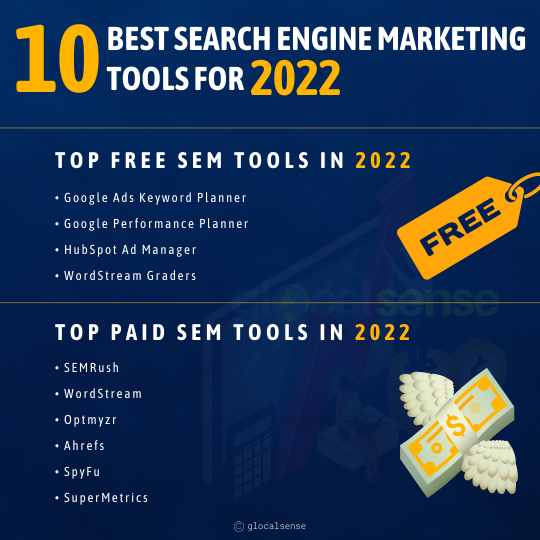
Top Paid SEM Tools in 2022 are:
• SEMRush
• Optmyzr
• Ahrefs
• SpyFu
Top Free SEM Tools in 2022 are:
Your budget and technical requirements will determine the best SEM tools for your company. Start with a free stand-alone tool to assist you in identifying long-tail keywords and rank for them if you’re a smaller company. Organizations and agencies may require a packaged service like WordStream or Ahrefs with a higher budget. These tools are very helpful for creating and adjusting search engine marketing plans. Anyone can use the Google Ads feature to promote an e-commerce business or a personal blog post on the internet.
Why an SEM tool matters
SEM automation via an enterprise platform can boost efficiency and productivity in several ways:
1. Better workflow: Day-to-day management of ad groups, ad copy, keyword lists, and bidding is more straightforward, and manual reporting and optimization take less time.
2. Smarter decisions: Businesses can keep up with quick changes in ad formats, search engine requirements, and monitoring systems by keeping updated. Multichannel reporting and attribution also enable faster reporting, improved analytics, and deeper insights into customer behavior.
3. Increased performance: All campaign data is collected in one place by a single platform, which may then be used to gain critical insights, such as how multiple marketing channels might work together to improve campaign performance.
